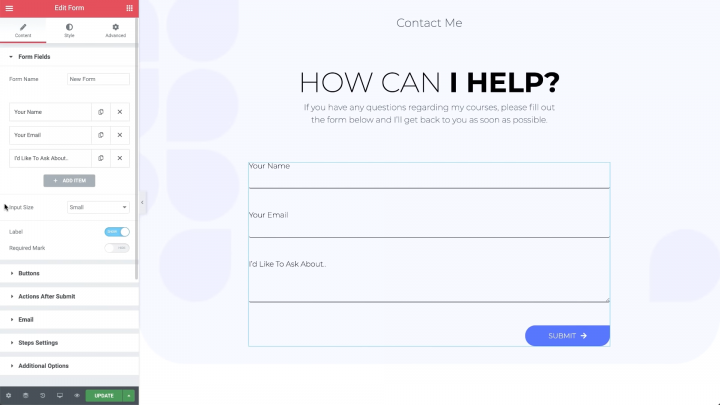

- #ELEMENTOR PRO FORM HOW TO#
- #ELEMENTOR PRO FORM INSTALL#
- #ELEMENTOR PRO FORM FULL#
Sheet Headers mapping with form fields – Once users have created sheet headers, it will auto create the new on clicking in settings page and map the sheet headers with form fields. Sheet Header Sorting – Once users have created new sheet names and if they are not in sorted manner they can also be arranged in sorted form. Add/Remove Sheet Headers – Users can easily add sheet names in sheet headers, also after adding it can also be removed from sheet headers. It can be access easily also enable/disable whenever we need it. Freeze Header – User can easily freeze header row (first row) of the sheet with setting page option. New Sheets – Once user will select and create new spreadsheet with settings option, it will auto create the new spreadsheet and sheets based on the name in settings page. New Speadsheets – Once user will select and create new spreadsheet with settings option, it will auto create the new spreadsheet in google drive. Google Spreadsheet can save your entries of your Elementor Form. Save Entries – We can easily save all the entries with one Google Spreadsheet to make your enquiries/data effective. And if you’re not, click below to purchase Elementor Pro and get started.Demo ElementorSheets WordPress Plugin ElementorSheets WordPress Plugin Features If you’re already using Elementor Pro, try out the form widget today. However, for the ways in which most people use forms, it’s got everything you need in a really convenient package. It is missing a few things that advanced form builders offer ( e.g. You can create your forms without leaving the Elementor interface, which is really convenient. This saves you money and helps you simplify your install/avoid compatibility issues. If you’re already using/interested in using Elementor, it eliminates the need to purchase and/or install a separate form plugin. It can do everything most people need, especially if you pair it with the Zapier integration. Overall, I think that Elementor form builder is a great tool for several reasons: To learn more about everything that Elementor Pro offers, check out our full Elementor review.
1,000 sites ( essentially unlimited) – $199. You can also redirect people to a custom thank you page after they submit the form. Speaking of notifications, you can also customize the email notifications that both you and form submitters receive. For example, you can receive notifications via Slack or Discord when someone fills out your form. There are also some other interesting options. 
If your tool isn’t covered, there’s also a catchall Zapier integration that lets you connect to any one of the thousands of tools on Zapier. To help you use your forms in useful ways, Elementor Pro has 12+ integrations with popular email marketing services and CRMs. You can also divide your forms into multiple pages to create multi-step forms, which is great for lengthy forms. I don’t think you’ll find any standalone form plugin with as robust of a design system.įrom there, you can add 18+ different field types: Elementor Forms Builder Featuresīefore going hands-on with Elementor forms builder, let’s quickly run over some of its key features.įirst off, one of the most defining features is that it’s integrated into the Elementor interface, which also means that you get access to the many, many Elementor design/style/layout options.
In our hybrid Elementor forms builder review/tutorial, we’ll take you through everything this widget offers and show you how to use it. That latter feature is what I’m going to focus on in this post – the Elementor forms builder.ĭid you know that, with Elementor Pro, you probably don’t need a third-party form plugin? Elementor Pro’s form widget lets you set up flexible forms (with integrations) right from the Elementor interface.

In fact, we use Elementor to power everything from our home page down to our contact forms. It’s no secret that we like Elementor here at WPLift.







 0 kommentar(er)
0 kommentar(er)
